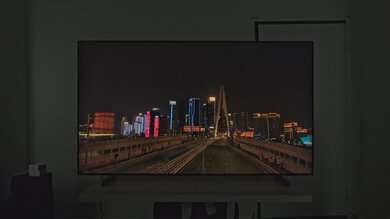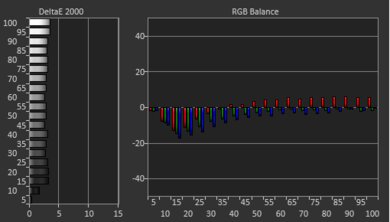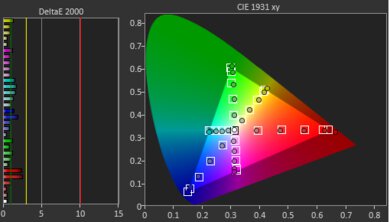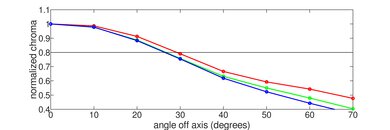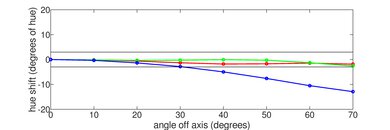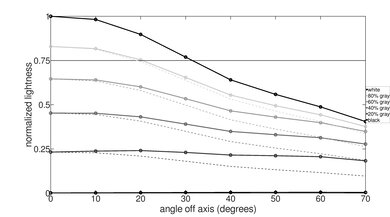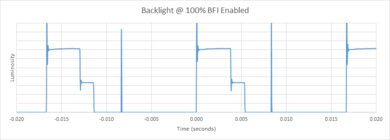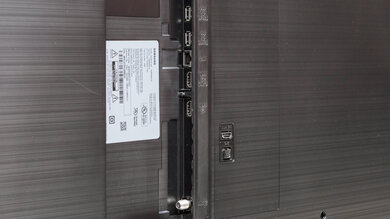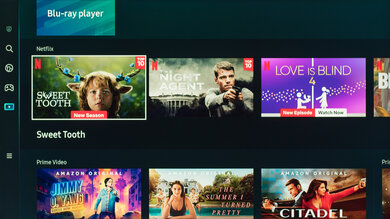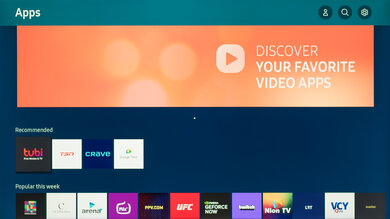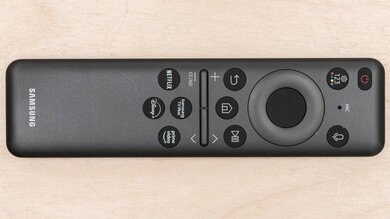The Samsung Q60C QLED is an entry-level TV in Samsung's 2023 lineup and is the lowest-end model in their QLED, or Quantum Dot LED lineup. It sits below the Samsung Q70C QLED, replacing the Samsung Q60B QLED from 2022. As an entry-level model, it's limited in features as it doesn't have local dimming, HDMI 2.1 bandwidth, or variable refresh rate (VRR) support. Although it runs a slightly simplified version of Samsung's Tizen smart platform, it's still easy to use and has a ton of available apps, so you're sure to find your favorite streaming service.
Our Verdict
The Samsung Q60C QLED is a decent TV overall. It's best suited for watching shows or sports during the day, as it has very good peak brightness in SDR and decent reflection handling. It's okay for watching movies, as dark scenes look good overall thanks to its high native contrast ratio, but it lacks a local dimming feature and can't get bright in HDR, so bright highlights don't stand out. It has low input lag for a responsive gaming or desktop experience, but it's just alright for gaming due to its slow response time.
- High native contrast for deep blacks.
- Incredible black uniformity.
- Bright enough to overcome glare in a moderately-lit room.
- Narrow viewing angle.
- Bad low-quality content smoothing.
The Samsung Q60C QLED is an okay TV for watching shows during the day. It gets bright enough to overcome glare in a moderately-lit room, and thanks to its decent reflection handling, visibility isn't an issue. It has decent upscaling and sharpness processing, which is great if you like to watch older shows. Sadly, it has a sub-par viewing angle, so it's not ideal for a wide seating arrangement, as the image degrades when viewed from the side.
- Bright enough to overcome glare in a moderately-lit room.
- Good selection of streaming apps.
- Narrow viewing angle.
- Bad low-quality content smoothing.
The Samsung Q60C QLED is just okay for watching sports during the day. Visibility in a moderately-lit room isn't an issue, as it gets bright enough to overcome glare and it has decent reflection handling. Sadly, it has a slow response time, so fast action looks blurry, and it's hard to make out fine details. It also has a narrow viewing angle, so it's not a good choice for watching the big game with a large group of friends, as the images fades and looks washed out from the sides.
- Bright enough to overcome glare in a moderately-lit room.
- Good selection of streaming apps.
- Narrow viewing angle.
- Slow response time results in very noticeable motion blur.
The Samsung Q60C QLED is just alright for playing video games. It has very low input lag in Game Mode, ensuring a responsive gaming experience with little delay between your actions and the action on-screen. Sadly, it has a slow response time, and there's a long blur trail behind fast-moving objects. It also lacks any advanced gaming features like VRR, and it's limited to a 60Hz refresh rate, so you can't take full advantage of the latest consoles.
- High native contrast for deep blacks.
- Incredible black uniformity.
- Low input lag.
- Lacks a local dimming feature to improve contrast.
- Slow response time results in very noticeable motion blur.
- No advanced gaming features like VRR.
The Samsung Q60C QLED is a decent TV for watching movies. It has a high native contrast ratio and superb black uniformity, so blacks are deep and uniform in dark scenes. It can display a wide color gamut, making colors look vivid and lifelike. On the other hand, it lacks a local dimming feature and has low peak brightness in HDR, so bright highlights don't stand out, and dark areas are washed out in bright scenes. It also has limited processing, so it can't smooth out low-quality content very well, and there's noticeable banding in gradients.
- High native contrast for deep blacks.
- Incredible black uniformity.
- Displays a wide range of colors.
- Lacks a local dimming feature to improve contrast.
- Low HDR peak brightness.
- Bad low-quality content smoothing.
The Samsung Q60C QLED is an okay TV overall for gaming in HDR. It has a high native contrast ratio, so blacks are deep and uniform in dark scenes. It lacks a local dimming feature, though, and it can't get very bright in HDR, so bright highlights don't stand out. It has a great color gamut, so colors are vibrant and lifelike overall, but again, they're not very bright. Finally, it delivers an alright gaming experience overall, with low input lag for a responsive feel but no advanced gaming features and a slow response time, so motion is blurry.
- High native contrast for deep blacks.
- Incredible black uniformity.
- Low input lag.
- Displays a wide range of colors.
- Lacks a local dimming feature to improve contrast.
- Slow response time results in very noticeable motion blur.
- No advanced gaming features like VRR.
- Low HDR peak brightness.
The Samsung Q60C QLED is decent for use as a PC monitor. It displays chroma 4:4:4 signals properly, which is essential for clear text from a PC. It has low input lag, so your cursor movements feel responsive, but sadly, it has a slow response time, and motion is blurry. It has very good peak brightness in SDR and can overcome glare in a moderately-lit room, and it has decent gray uniformity, with very little dirty screen effect in the center of the screen. Unfortunately, it has a narrow viewing angle, so the sides of the screen fade and look washed out if you're sitting too close.
- Low input lag.
- Chroma 4:4:4 is displayed properly for clear text from a PC.
- Narrow viewing angle.
- Slow response time results in very noticeable motion blur.
- No advanced gaming features like VRR.
Changelog
- Updated May 16, 2024: Mentioned the newly-reviewed Samsung Q60D QLED in the HDR Brightness section of this review.
- Updated Apr 11, 2024: Mentioned the newly-reviewed Samsung DU8000 in the Response Time section of this review.
- Updated Feb 16, 2024: Added mention of the Samsung store online exclusive QE1C variant in the Differences Between Sizes and Variants.
- Updated Sep 11, 2023: We corrected a typo in the introduction and fixed two broken links.
Check Price
Differences Between Sizes And Variants
We bought and tested the 65-inch Samsung Q60C, and it's also available in 32-inch, 43-inch, 50-inch, 55-inch, 70-inch, 75-inch, and 85-inch sizes. All sizes offer similar picture quality and overall performance.
Note that with Samsung TVs, the six letters after the short model code (AFXZA in this case) vary between specific retailers and regions and even between different retailers. The Samsung QE1C is a Samsung store online exclusive that performs the same, but it's only available in 70-inch and 85-inch sizes. There are also a few international variants of this TV that perform roughly the same. The Samsung Q65C has a slightly better global dimming feature, and the Samsung Q67C has a center-mounted stand.
| Size | US Model |
|---|---|
| 32" | QN32Q60CAFXZA |
| 43" | QN43Q60CAFXZA |
| 50" | QN50Q60CAFXZA |
| 55" | QN55Q60CAFXZA |
| 65" | QN65Q60CAFXZA |
| 70" | QN70Q60CAFXZA |
| 75" | QN75Q60CAFXZA |
| 85" | QN85Q60CAFXZA |
Our unit was manufactured in March 2023; you can see the label here.
Popular TV Comparisons
The Samsung Q60C is a basic entry-level 4k TV with just okay picture quality and few extra features. It's overpriced, and you can get cheaper TVs from budget brands like Hisense and TCL that are just as good and offer a better selection of features, like the Hisense U6/U6H, Hisense U7H, or TCL 5 Series/S555 2022 QLED.
See our recommendations for the best Samsung TVs, the best 65-inch TVs, and the best TVs for movies.
The Samsung Q60C and the Samsung Q60D are essentially the same TV with one difference: the Q60D gets brighter when watching movies or playing games in HDR, so highlights stand out more on it, leading to a more impactful HDR experience. The Q60D also has a faster response time, but it's still slow overall, so fast motion is still blurry.
The Samsung Q60C and the Samsung Q60B are nearly identical. Most of the differences between them are within the margins of individual panels.
The Samsung Q60C is a bit better than the Samsung CU8000. The Q60C is a lot brighter, so it can better overcome glare in a moderately lit room, and HDR looks better.
The Samsung Q70C is better than the Samsung Q60C. The Q60C has slightly better contrast and vastly better black uniformity but is worse in every other category. The Q70C is also a fully featured gaming TV, with four HDMI 2.1 bandwidth ports for up to 4k @ 120Hz gaming and support for every VRR technology, while the Q60C is limited to up to 4k @ 60Hz on its four HDMI 2.0 ports, and has no VRR support.

We buy and test dozens of TVs yearly, taking an objective, data-driven approach to deliver results you can trust. Our testing process is complex, with hundreds of individual tests that take over a week to complete. Most of our tests are done with specially designed test patterns that mimic real content, but we also use the same sources you have at home to ensure our results match the real-world experience. We use two main tools for our testing: a Colorimetry Research CR-100 colorimeter and a CR-250 spectroradiometer.
Test Results

As part of our two-year test, which has so far subjected 100 TVs to over 10,000 hours of accelerated testing, we found that edge-lit TVs like this one have significant durability issues. These issues range from warped reflector sheets and cracked light guide plates to completely burnt-out LEDs. You can read the full results of our investigation here.
The stand has wide-set plastic feet which support the TV well. Because the stand is so wide, you'll need a big table to place it on. The stand can be placed in the lower position as shown, which raises the screen about 1.9" above the table, or in the raised position (shown here), which raises the screen about 2.9" above the table. Most soundbars fit in front of it in the raised position without blocking the screen.
Footprint of the 65-inch TV: 42.4" x 10.9".
The back of the TV is made of plastic and has a nice brushed finish. Unfortunately, there are no clips or guides for cable management, so it's hard to maintain a clean setup. Sadly, the inputs are recessed into the TV, so they're hard to reach if you wall-mount the TV with a fixed bracket, so a mounting arm is recommended.
The Samsung Q60CD has decent build quality. The stand supports the TV fairly well but wobbles front and back easily. The TV is almost entirely made of plastic, and there's some flex to the large panel on the back, but this won't cause any issues. Overall, its build quality has no major flaws or issues, but it's not very premium, and some of the materials used feel a bit cheap.
This TV doesn't have a local dimming feature, so it can't adjust the backlight of individual zones to brighten up highlights without impacting the rest of the image. But this means that there's no distracting flicker or brightness changes as bright highlights move between zones.
Unfortunately, this TV has poor peak brightness in HDR. Highlights don't stand out, and it doesn't have a local dimming feature to help make bright objects pop.
These measurements are after calibrating the HDR white point, with the following settings:
- Picture Mode: FILMMAKER Mode
- Brightness 50
- Contrast: Max
- Color Temperature: Warm 2
- HDR Tone Mapping: Static
Changing HDR Tone Mapping to 'Active' results in a slightly dimmer image overall.
| Scene | Brightness | Photo |
| Hallway Lights | 294.7 cd/m² | 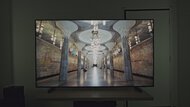 |
| Yellow Skyscraper | 111.3 cd/m² | 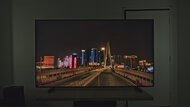 |
| Landscape Pool | 84.3 cd/m² | 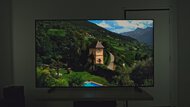 |
Check out the 2024 Samsung Q60D QLED if you want a very similar TV with better HDR brightness.
Switching to Game Mode increases the peak brightness a bit, but it's not a noticeable difference, and it's still too low for a good HDR experience.
These measurements are after calibrating the HDR white point, with the following settings:
- Picture Mode: Game
- Brightness 50
- Contrast: Max
- Color Temperature: Warm 2
- HDR Tone Mapping: Static
- Game HDR: Basic
The PQ EOTF tracking is superb on this TV. Dark scenes and midtones are displayed close to the content creator's intent. Like most LED TVs, near-blacks are raised a bit, but other than that, it tracks the content creator's intent well. There's a sharp cutoff near the TV's peak brightness, though, which causes a loss of fine details in bright highlights.
The Samsung Q60CD QLED has very good peak brightness in SDR. It's bright enough to overcome glare in a moderately-lit room, and there's no variation in brightness between most scenes. The TV's global dimming feature (also known as CE dimming) dims fine details in low APL scenes, though.
These measurements are after calibration with the following settings:
- Picture Mode: Movie
- Backlight: Max
- Gamma: 2.2
- Color Tone: Warm 2
The HDR color gamut is great. It has excellent coverage of the DCI-P3 color space, which is used in most HDR content. The TV's tone mapping is great with saturated colors, but muted colors are slightly off. However, it's not future-proof because it has limited coverage of the Rec. 2020 color space, which more content will start to use, and its Rec. 2020 tone mapping with green and cyan is off. You can see the spectral power distribution (SPD) for this TV here.
Although it can display a wide color gamut, this TV's color volume is just decent. It can display dim colors well for the most part, but bright shades of blue aren't as bright as other colors.
The Samsung Q60 has great accuracy in SDR even before calibration. Color accuracy is excellent, with no noticeable issues. The white balance is slightly off in all shades of gray, but not noticeably. Gamma doesn't follow the 2.2 target for a moderately-lit room, especially in dark scenes, which are crushed a bit.
The accuracy after calibration is fantastic. It's a bit tricky to calibrate, and although the white balance after calibration is nearly perfect, colors are still a bit off, and gamma below 30% is still a bit too dark.
You can see our full calibration settings here.
The gray uniformity is decent. The sides of the screen are a bit darker than the center, but it's not noticeable with most real content. There's a bit of dirty screen effect in the center of the screen, which is distracting when watching sports. Near-dark scenes look much better, with no significant issues.
Sadly, the viewing angle of the Samsung Q60CD QLED is sub-par. The image fades rapidly as you move off-center, and colors shift, giving the image a more yellow tint. Black levels rise rapidly, and brightness decreases, causing the image to appear washed out. Overall, this isn't a good TV for a wide seating arrangement or if you like to move around with the TV.
The Samsung Q60 has mediocre gradient handling in HDR. There's bad banding in bright greens, and noticeable banding in dark greys, reds, and greens, as well as in light grays, reds, and blues.
The Samsung Q60 QLED has decent upscaling and sharpness processing. Fine details in low-resolution content are displayed well, but text is a bit blurry, and the image is a bit soft overall.
The optimal sharpness settings for low-resolution or low-bitrate content, with no over-sharpening, are as follows:
- Sharpness: 6
- Picture Clarity: Off
This TV uses a BGR subpixel layout, which doesn't impact the image quality, but it makes text look blurry in some applications that don't support the BGR layout, which is important if you want to use it as a PC monitor. You can read more about it here.
Unfortunately, the Samsung Q60 QLED TV has an inadequate response time. All motion looks blurry, and there's noticeable black smearing with dark objects, so dark scenes and shadow details look even worse. If you want a Samsung TV with a faster response time, check out the Samsung DU8000.
The Samsung Q60 TV uses pulse width modulation (PWM) to dim the backlight at all brightness levels. It flickers at 480Hz in Movie mode, which can be distracting if you're sensitive to the flicker, and it drops down to 120Hz in the 'Dynamic', 'Standard', 'Filmmaker', and 'Game' modes, or with Picture Clarity enabled. This lower flicker causes image duplication with 60 fps content and can cause headaches if you're sensitive to image flicker.
There's an optional feature to introduce backlight strobing to reduce persistence blur, commonly known as Black Frame Insertion (BFI). It flickers at 60Hz when enabled, but the timing is off, resulting in noticeable image duplication. This feature also reduces the panel's brightness.
There's a motion interpolation feature to bring lower-frame-rate content up to 60 fps, but it doesn't look very good on this TV. There are tons of artifacts on screen with any fast motion, and there's haloing present around characters in pretty much any scene.
Thanks to its slow response time, this TV has very little 24p stutter.
The Samsung Q60C can remove judder from any 24p source, like a Blu-ray player or a streaming device with a 'Match Frame Rate' feature. Unfortunately, it can't remove judder from 60Hz sources, like most cable boxes.
This TV is limited to a 60Hz refresh rate and doesn't support a variable refresh rate to reduce screen tearing.
The Samsung Q60C has fantastic low input lag, ensuring a responsive gaming or desktop experience.
The Samsung Q60C supports all common resolutions up to 4k @ 60Hz. It displays chroma 4:4:4 properly with any signal, which is important for reading clear text from a PC, but you need to ensure you're in PC Mode. If you'd like a similar TV but with up to 4k @ 120Hz support, check out the higher-tier Samsung Q70C QLED instead.
As this TV has HDMI 2.0 bandwidth and no VRR support, it has limited compatibility with the advanced gaming features of the PS5. The Auto Low Latency Mode automatically switches the TV into Game Mode when you play a game from a compatible device, and you don't need to change any settings.
Since this TV has HDMI 2.0 bandwidth and no VRR support, it has limited compatibility with the advanced gaming features of the Xbox Series X and S. The Auto Low Latency Mode automatically switches the TV into Game Mode when you play a game from a compatible device; you don't need to change any settings.
The Samsung Q60C has eARC support, allowing you to passthrough lossless Dolby Atmos audio to a compatible receiver. However, as it doesn't support any DTS or DTS:X signals and many Blu-rays use this audio format, you'll need to connect your Blu-ray directly to your receiver to get the best audio experience.
This TV has an okay frequency response. The sound profile is well-balanced at moderate listening levels, so most dialogue is crisp and easy to understand. It doesn't get very loud, though, and like most TVs, there's very little bass. A soundbar or a dedicated surround sound setup is recommended for the best sound possible. See the best soundbars for watching movies.
The distortion handling is okay. There's very little noticeable distortion at moderate listening levels. It's a bit worse at max volume, but still not distracting.
The TV has the same Tizen smart interface as higher-end models but a simpler interface with fewer animations. It doesn't have a room correction feature or Intelligent Mode settings, but it's user-friendly, and navigating the menus feels smooth and easy.
The remote is compact and has very few buttons. It has built-in voice control, though, which you can use to change inputs, launch apps, or search for content. The remote has a built-in battery; you can recharge it via USB-C or the solar panel on the back.











